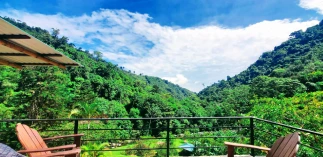Perched proudly on a moss-covered branch, the Hairy Woodpecker is a common sight in the mountainous regions of Costa Rica. This medium-sized woodpecker, easily identified by its bold black and white plumage and impressive drumming, is a vital part of the highland ecosystem.
A Striking Appearance
The Hairy Woodpecker is a stunning bird, adorned in a classic black and white tuxedo. Its back is jet black, adorned with a crisp white stripe running down its center. The wings are checkered with bold white markings, creating a dazzling display in flight. A peek of red adds a touch of vibrancy, with males sporting a small patch on the nape of their necks.
One of the key features that distinguishes the Hairy Woodpecker from its close relative, the Downy Woodpecker, is its bill. The Hairy Woodpecker boasts a longer bill, almost as long as its head, perfect for excavating deep into trees. Keep an eye out for this key difference as you explore the forests!
A Master of Percussion
The Hairy Woodpecker is a true drummer of the forest. Using its powerful bill, it raps rhythmically on trees, creating a loud resonating sound that can be heard echoing through the mountains. This drumming serves a dual purpose: communication and foraging. The woodpecker uses its drumming to attract mates and defend its territory, while also using the vibrations to locate hidden insect larvae beneath the bark. Once located, the woodpecker’s long, barbed tongue expertly extracts the unsuspecting prey.
A Crucial Role in the Ecosystem
The Hairy Woodpecker plays a critical role in maintaining the health of the Costa Rican forests. By preying on insects that can damage trees, they act as natural pest controllers. In addition, the woodpecker creates cavities in trees by excavating for food and shelter. These abandoned cavities then provide vital nesting sites for a variety of other bird species, promoting biodiversity within the ecosystem.
Spotting the Hairy Woodpecker
The Hairy Woodpecker is most commonly found in the mountainous regions of Costa Rica, inhabiting mature forests with large trees. While they prefer these wilder areas, they are occasionally spotted in well-wooded suburban areas and parks.
If you’re hoping to catch a glimpse of this fascinating bird, keep an eye out for their distinctive black and white plumage and listen for their loud drumming calls. With a little patience and a keen eye, you might just be lucky enough to spot this powerful percussionist in the heart of the Costa Rican mountains.
Tips for Birdwatching in Costa Rica
- Early Bird Gets the Worm: Birds are most active in the early morning and late afternoon hours, so plan your birding adventures for these times.
- Dress for the Occasion: Wear comfortable clothing and shoes suitable for hiking through uneven terrain.
- Pack Essentials: Bring binoculars, a field guide, a camera, and plenty of water to stay hydrated.
- Be Patient and Observant: Birding requires patience and a keen eye. Move slowly and quietly, and listen carefully for bird calls.
- Join a Guided Tour: Consider joining a guided birding tour led by an experienced guide who can help you spot and identify different bird species.
By following these tips and keeping an eye out for the Hairy Woodpecker’s striking appearance and rhythmic drumming, you’re sure to have a memorable birding experience in the breathtaking Costa Rican highlands.
For more information, please view our comprehensive guide about the birds of Costa Rica







